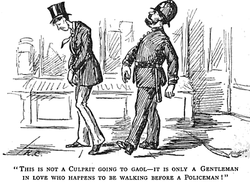Randolph Caldecott
Caldecott also illustrated novels and accounts of foreign travel, made humorous drawings depicting hunting and fashionable life, drew cartoons and he made sketches of the Houses of Parliament inside and out, and exhibited sculptures and paintings in oil and watercolour in the Royal Academy and galleries.
In 1848, the family moved to Challoner House, Crook Street, Chester, and in 1860 to 23 Richmond Place, Boughton, a village just outside the city.
In that same year, 1861, he first had a drawing published, a sketch of a fire at the Queen Hotel, Chester which appeared in the Illustrated London News, together with his account of the blaze.
When he was out on errands, he was either walking or riding around the countryside, and many of his later illustrations incorporate buildings and scenery of Cheshire and that part of Shropshire.
It was a habit of his at this time, which he maintained all his life, to decorate his letters, papers and documents of all descriptions with marginal sketches to illustrate the content or provide amusement.
Encouraged by this evidence of his ability to support himself by his art, Caldecott decided to quit his job and move to London; this he did in 1872 at the age of 26.
He remained in London for seven years, spending most of them in lodgings at 46 Great Russell Street just opposite the British Museum, in the heart of Bloomsbury.
While there he met and made friends (as he did very readily) with many artistic and literary people, among them Dante Gabriel Rossetti, George du Maurier (who was a fellow contributor to Punch), John Everett Millais, and Frederic Leighton.
In another milieu Caldecott followed The Harz Mountains with illustrations for two books by Washington Irving, three for Juliana Ewing, another of Henry Blackburn's, one for Captain Frederick Marryat and for other authors.
In the autumn of 1882, the Caldecotts left Kent and bought a house, Broomfield, at Frensham in Surrey; they also rented No 24 Holland Street, Kensington.
Caldecott's health was generally poor and he suffered much from gastritis and a heart condition going back to an illness in his childhood.
He and Marian had sailed to New York and travelled to Florida in an unusually cold February; Randolph was taken ill and died at St. Augustine.
Gleeson White wrote of Caldecott: Caldecott was a fine literary artist, who was able to express himself with rare facility in pictures in place of words, so that his comments upon a simple text reveal endless subtleties of thought ... You have but to turn to any of his toy-books to see that at times each word, almost each syllable, inspired its own picture ...


